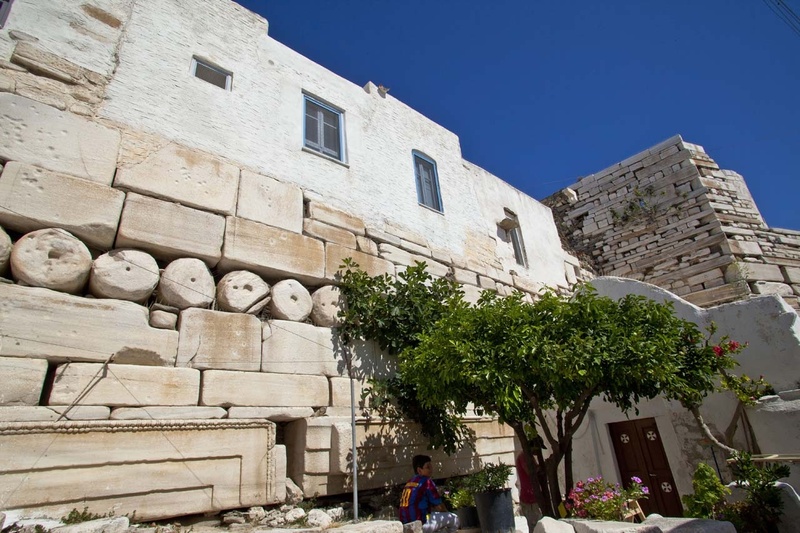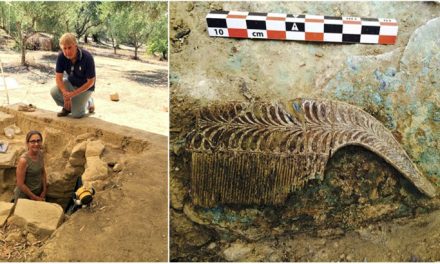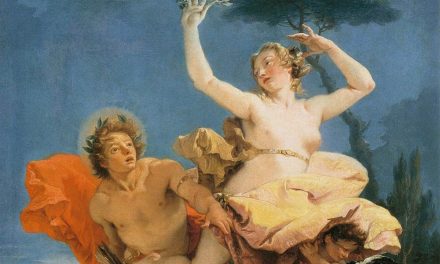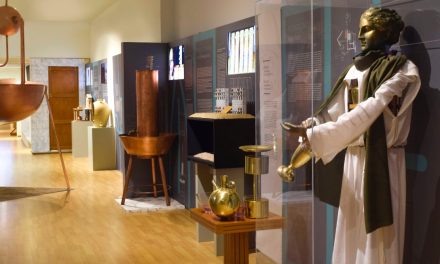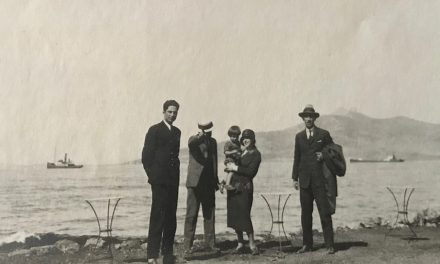The island of Paros was renowned in antiquity for its white marble quarries. The so-called “Parian marble” was highly prized for its exceptional quality – white, clean, fine-grained, and with a crystalline texture – making it ideal for sculpture and architecture. It is considered the most translucent marble in the world. Many masterpieces of Greek sculpture were carved from this pure white, luminous material. Today, the ancient quarries are regarded as monuments of industrial archeology. Recently, an ancient sculpture workshop was uncovered during excavations on the island. (Cover photo: Marble elements embedded in the Venetian Castle of Parikia, Paros, Source: aegeanislands.gr )
Parian marble (“Paria Lithos”) was already in use during the early Bronze Age, likely collected in the form of pebbles for the creation of figurines and utensils. Quarrying began in earnest in the 7th century BC, as evidenced by a tombstone depicting a seated female figure in low relief from the cemetery of Parikia. From the 6th century BC onwards, extraction intensified, and Parian marble began to be systematically quarried in large blocks for sculptural and architectural purposes. Semi-finished objects discovered in marble deposits from ancient activity in the pits and caves, including a stele bearing the inscription “city border”, provide evidence for the existence of workshops at the quarries sites and indicate that the exploitation of the marble may have been at least partially controlled by the state. Semi-finished objects discovered in marble deposits from ancient quarrying activity—such as a stele bearing the inscription “city border”—provide evidence for the existence of workshops at the quarry site. These findings also suggest that the exploitation of the marble may have been at least partially controlled by the state. (Source: https://parianmarble.com)
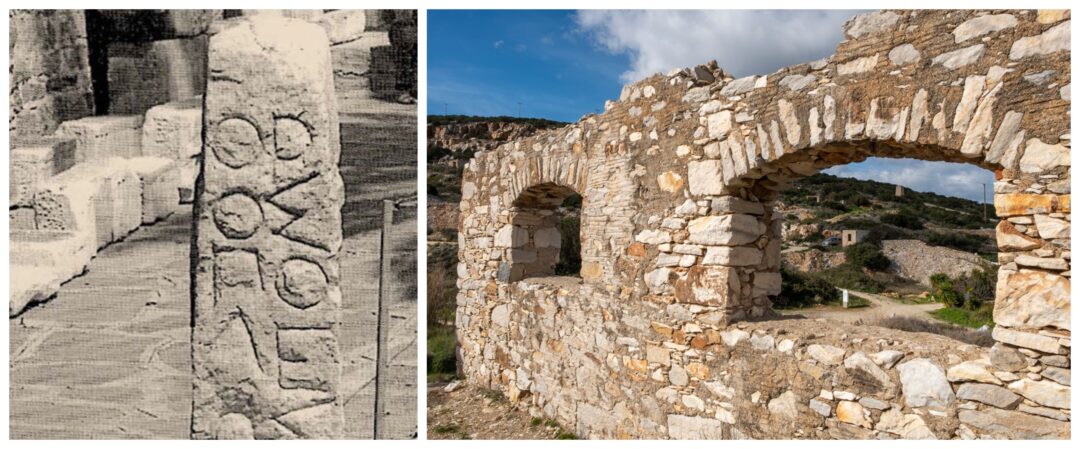
A stele (column) bearing the inscription “horos poleos” (marker of the city border), 4th century BC, found in the quarry of Lakkoi (left) (Source: https://parianmarble.com ). The valley of Skarpathiotis in Marathi, with the ancient galleries and the newer installations (right) (Source: Cycladic Identity Initiative)
The most important marble quarries of Paros are located on the northern side of Mount Marpissa, along the banks of the Skarpathiotis stream, east of the village of Marathi, approximately 5 km from Parikia, the island’s capital. These include the famous underground quarries of the Nymphs and of Pan. Other significant deposits lie slightly further west, such as the vast underground quarries at Spilies and the remains of surface quarries on the hill of Lakkoi and in Thapsana.
The most renowned variety of Parian marble, the high-quality “lychnite stone” or “lychnitis,” comes from the Skarpathiotis valley quarries near Marathi.” The name may derive either from the Greek word for lamp (λύχνος), referring to the oil lamps used to illuminate the underground galleries, or from the stone’s remarkable clarity. This variety was especially sought after for statuary due to its exceptional whiteness, fine grain, and high translucency. In terms of light transmission, lychnite marble allows up to 3.5 cm for light to pass through—compared to 2.5 cm for Carrara marble and 1.5 cm for Pentelic marble. In its highest quality form, Parian lychnite can transmit light up to 12 cm deep, giving sculptures a uniquely lifelike and plastic quality. (Source: https://parianmarble.com)

Ancient galleries at the Marathi marble quarries (Source: https://parianmarble.com, imagine.paros.gr)
The exceptional-quality marble extracted from the quarries of Mount Marpissa played a decisive role in the economic and cultural development of ancient Paros. The island became one of the most important artistic centers of the ancient world and was the birthplace of several renowned sculptors, including Aristion, Agoracritus, Aristander, Scopas, Thrasymedes, and others. Parian marble was used in many iconic structures and artworks, such as the Acropolis of Athens, the Temple of Apollo on Delos, the Temple of Poseidon at Sounion, the Thiseion, and the Ancient Agora of Athens. It also featured in the construction of the Mausoleum at Halicarnassus, the Temple of Solomon, the Monastery of Vlacherna in Istanbul, and numerous theaters, stadiums, and even palaces in Venice. (Source: https://parianmarble.com)
The following are ancient sculpture masterpieces carved from Parian marble, which decisively shaped the art of ancient Greece and contributed to its spread throughout the Western world, shaping the History of Art:
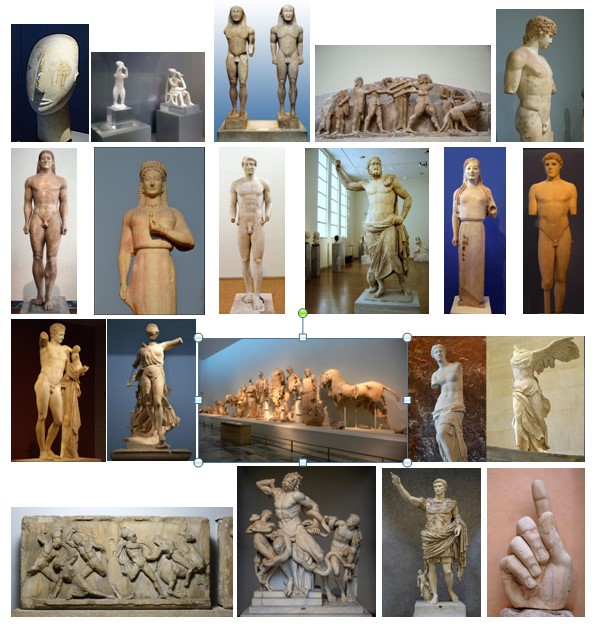
Head of a Cycladic statue, the Cycladic Αulos player and Harp player at the Archaeological Museum of Athens, Kleobis and Biton, Siphnian Treasury pediment, Antinous at the Archaeological Museum of Delphi, Kroisos Kouros from Anavyssos, Phrasikleia Kore, Aristodikos Kouros, Poseidon of Melos at the National Archaeological Museum of Athens, Peplos Kore, Kritios Boy at the Acropolis Museum, Hermes of Praxiteles, Nike of Paionios, Pediments of the Temple of Zeus at the Archaeological Museum of Olympia, Aphrodite of Milos, Nike of Samothrace at the Louvre Museum, Frieze of the Mausoleum of Halikarnassos at the British Museum, Laocoön and His Sons, Augustus of Prima Porta at the Vatican Museum, Hand of the colossal statue of Constantine the Great at the Capitol Museum (Source: Wikimedia)
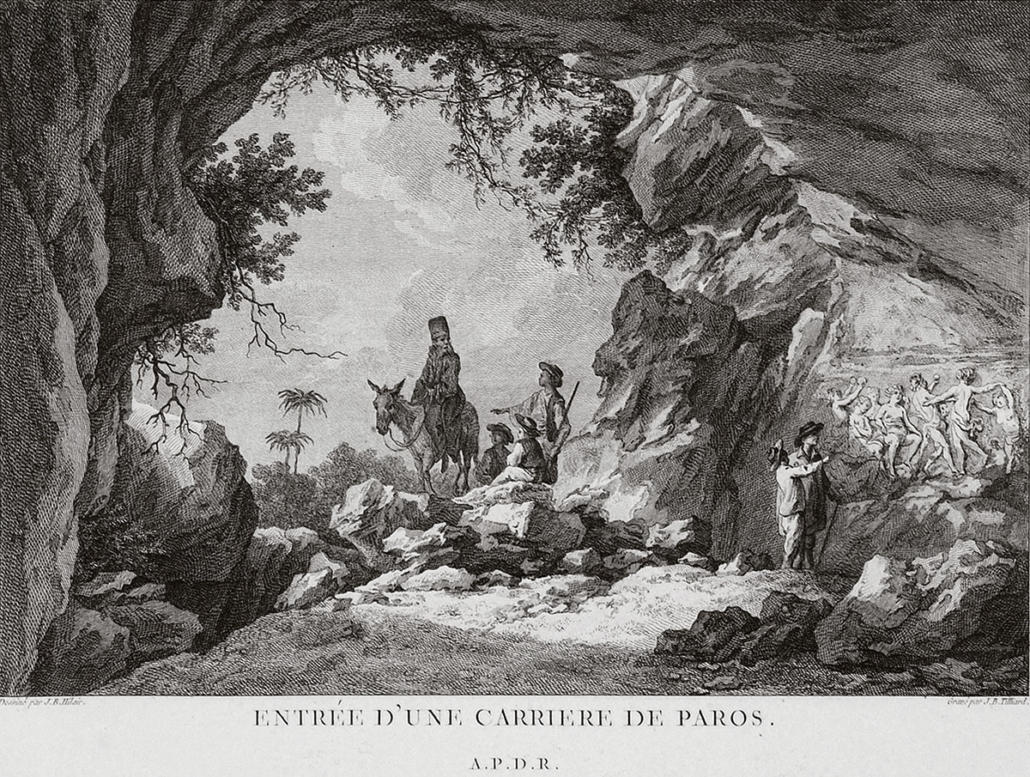
Marie Gabriel Florent Auguste de Choiseul-Gouffier, Entrance of a quarry in Paros, Voyage pittoresque de la Grèce, 1782 (Source: Aikaterini Laskaridis Foundation Library)
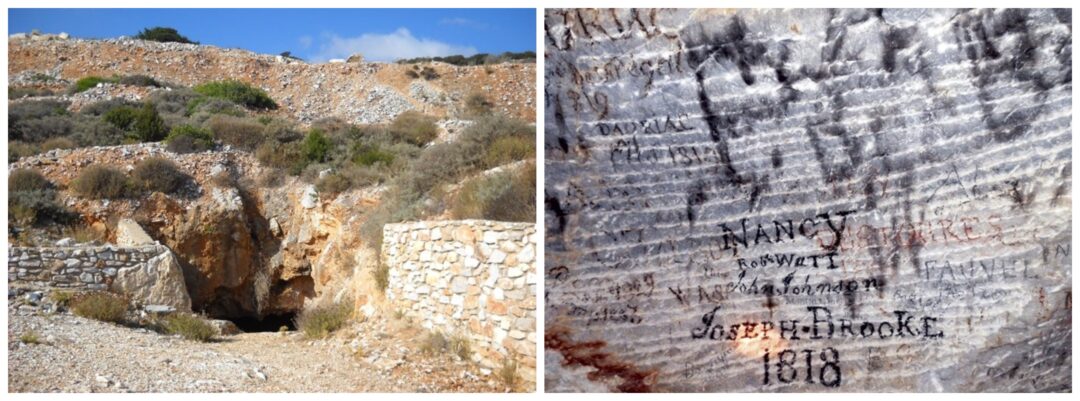
Entrance of the Quarry of Pan (left), Inscriptions with the names of visitors who descended into its deeper chambers visible on the quarry walls, such as Choiseul-Guffier 1776, Fauvel 1789, Power 1813, Brooke 1818, Dauriac 1819, Pradier 1833, Cordier 1858, Siegel 1861, and others (right) (Source: https://parianmarble.com)
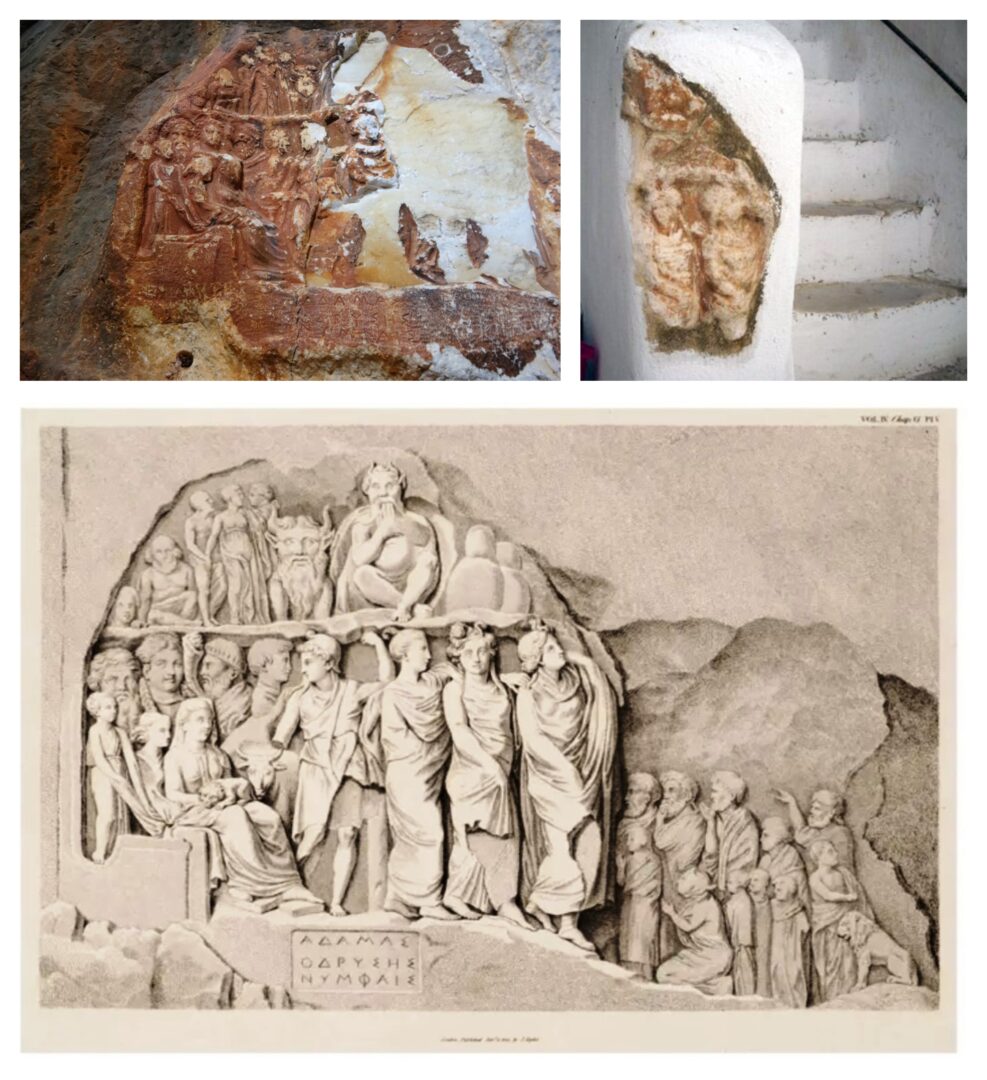
The Cave of the Nymphs is the oldest quarry, named after a votive inscribed relief carved into the natural stone on the left side of the south gallery, a tribute by Adamantas from Thrace to the Nymphs, a work of the 4th century BC (upper left). Part of the relief detached at the end of the 19th century, now inlaid in the monastery of St. Minas (upper right). Engraving of the relief by Stuart, James, and Nicholas Revett, 1816 (lower) (Source: https://parianmarble.com)
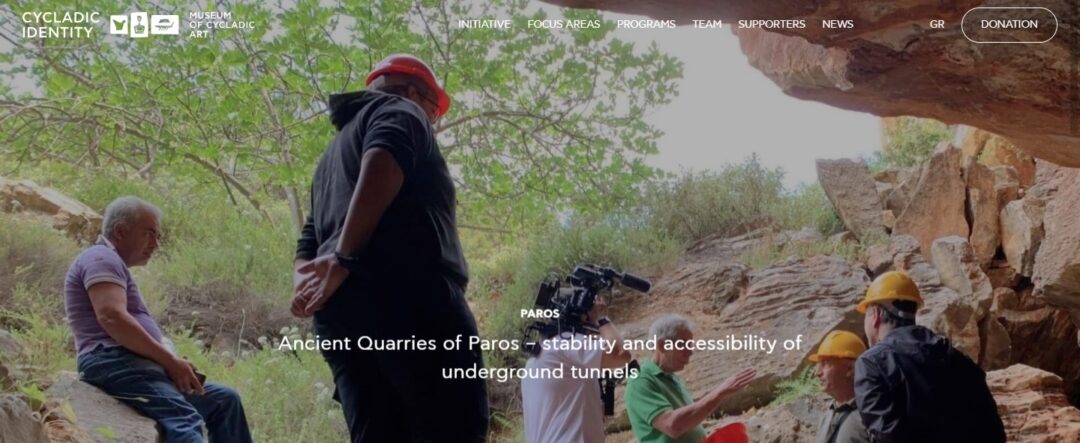
The well-preserved underground quarries of the Nymphs and Pan were until recently accessible to visitors, in an otherwise unorganized archaeological site, but the emergence of stability problems in the rock mass, led the Ephorate of Antiquities of Cyclades to temporarily prohibit entry, for safety reasons. The Cycladic Identity funding supports the implementation of the first stage of a series of studies and interventions in the Ancient Quarries of Paros, which aim at protecting and revealing their value, and reestablishing accessibility of visitors
An ancient sculpture workshop was recently discovered during excavations at the site of Parikia in Paros. The presence of marble chippings in various parts of the site, along with a significant number of unfinished marble sculptures that were discovered, provided the first strong indications of the operation of a sculpture workshop during the Hellenistic period. The earlier structures of the buildings are linked to earlier phases dated to the late 5th and 4th centuries BCE. Waste materials found in the site, including clay molds and seals, pigments, purple dye, and metal slag, confirm workshop activities in the wider area during a later period. The movable finds are of particular interest, including unfinished marble sculptures—primarily of Aphrodite—clay heads of female figures, as well as clay molds and seals. A very large quantity of pottery was also collected. (Source: Ministry of Culture)

Findings in excavations at the sculpture workshop in Parikia (from left to right): Fragment of a relief with a depiction of part of a couch, Unfinished statuette, possibly of Aphrodite, Female figurine head with complex hairstyle and earrings, Fragment of a terra sigillata vessel with a relief depiction of a theatrical mask, Fragment of a lamp disc with a depiction of a gladiator (Source: Ministry of Culture)
Paros has been an administrative and commercial hub in the Aegean Sea since antiquity. It experienced periods of great prosperity, as evidenced by the numerous archaeological artifacts and sites scattered across the island. High on the list of top Greek holiday destinations, Paros welcomes its visitors to the heart of the Cyclades with excellent tourist facilities. The island invites travelers to explore its natural beauty, including lovely beaches with crystal-clear waters, Byzantine footpaths that connect traditional villages, and breathtaking landscapes – all with enjoying its vibrant nightlife.
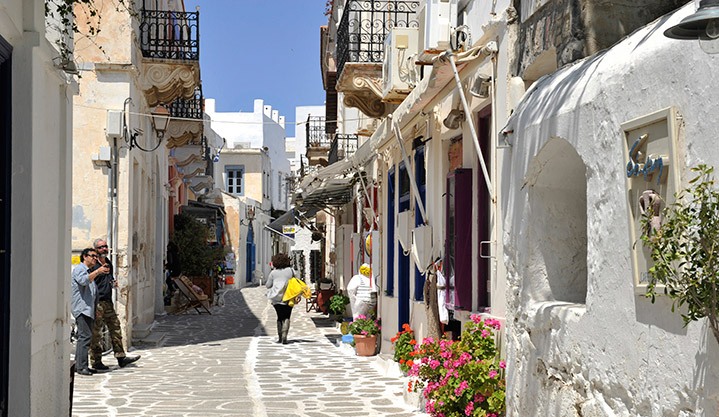
Parikia, located on the site of an ancient town, is both the port town and the capital of the island. Among the village’s white, cube-shaped houses, visitors can find neoclassical and medieval ruins. The Archaeological Museum of Paros showcases a wide variety of exhibits from the island’s archaeological sites—including the sanctuaries of the gods Asklepios (Asclepius), Pythios Apollo, and Delios—as well as remarkable prehistoric finds from the nearby islets of Antiparos, Despotiko, and Saliago (Source: imagine.paros.gr, visitgreece.gr)
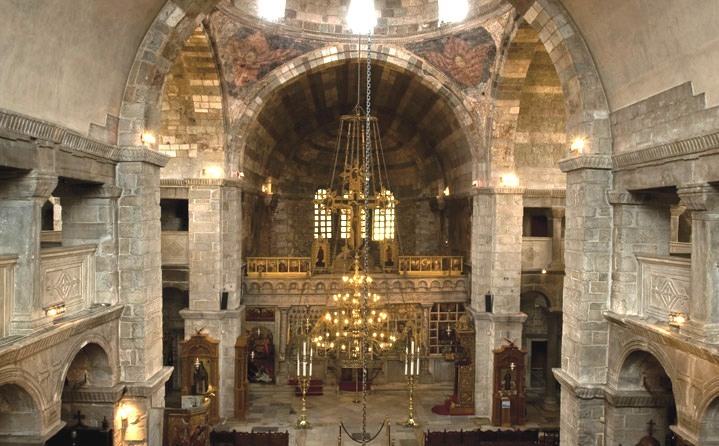
The Holy Shrine of Ekatontapiliani in Parikia, just a few steps from the port, was founded by Constantine the Great. The original church was built in the 4th century, and the oldest murals date from the 7th to8th century. The complex is structured like a monastery, featuring a courtyard, monastic cells, impressive chapels and a baptistery. Construction was overseen by Ignatius, a disciple of Anthemios, the master builder of the Hagia Sophia in Constantinople, and the architectural plan was nearly identical. It is estimated that over 2,500 marble ancient architectural elements were used in the construction of the church, the baptistery, and the chapel of Agios Nikolaos (Source: imagine.paros.gr)
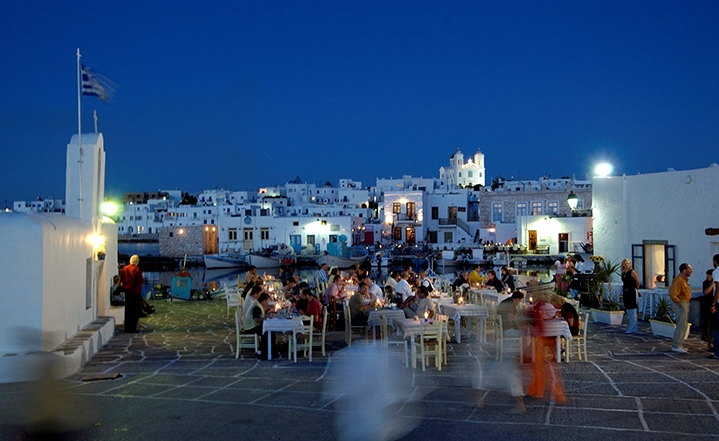
Naoussa, the second largest village of the island with the largest fishing fleet in the Cyclades, is on the north shore of the island and boasts beautiful Venetian architecture (Source: imagine.paros.gr)
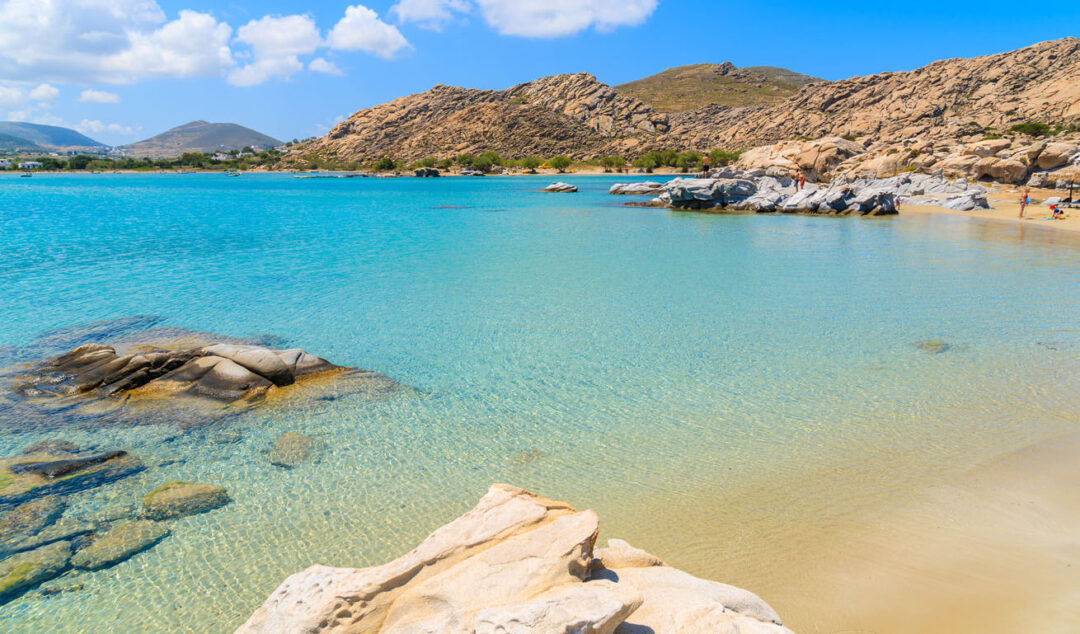
Kolibithres overlooks the bay of Naoussa, where granite rocks, eroded by salt, water, and air gradually descend to the sea, forming a series of unique, lunar-shaped beaches. Most beaches on the wind-swept island of Paros – covered mainly with fine sand – are situated next to modern, well-equipped facilities for all kinds of water sports, providing visitors with carefree and stimulating fun (Source: Visitgreece.gr, imagine.paros.gr)
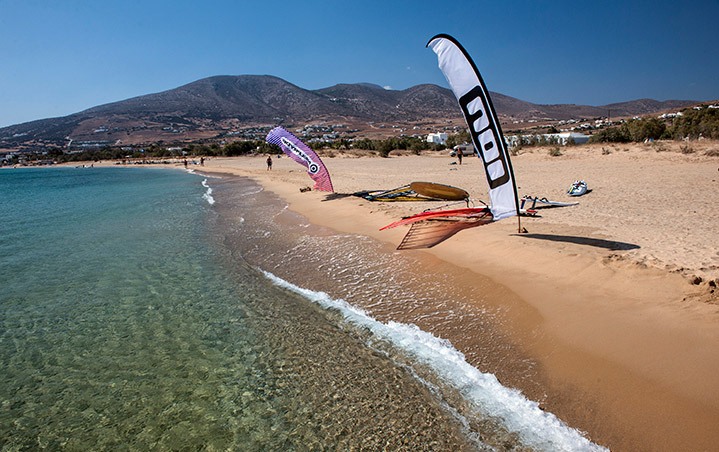
Chryssi Akti, named after the golden sand that covers it, is the most popular beach for windsurfing. The waters around Paros are widely considered a surfer’s paradise, making it a top choice for Greek and international athletes. The PWA (Professional Windsurfers Association) World Championship was once held on the island (Source: imagine.paros.gr, visitgreece.gr)
Read also:
Cycladic architecture, stunningly blending with the endless blue of the Aegean sea
Cycladic Identity: keeping alive the heart of the Cyclades
Yannos Kourayos, bringing the archaeological site of Despotiko to life
I.A.
TAGS: ARCHAEOLOGY | CYCLADES | TOURISM

